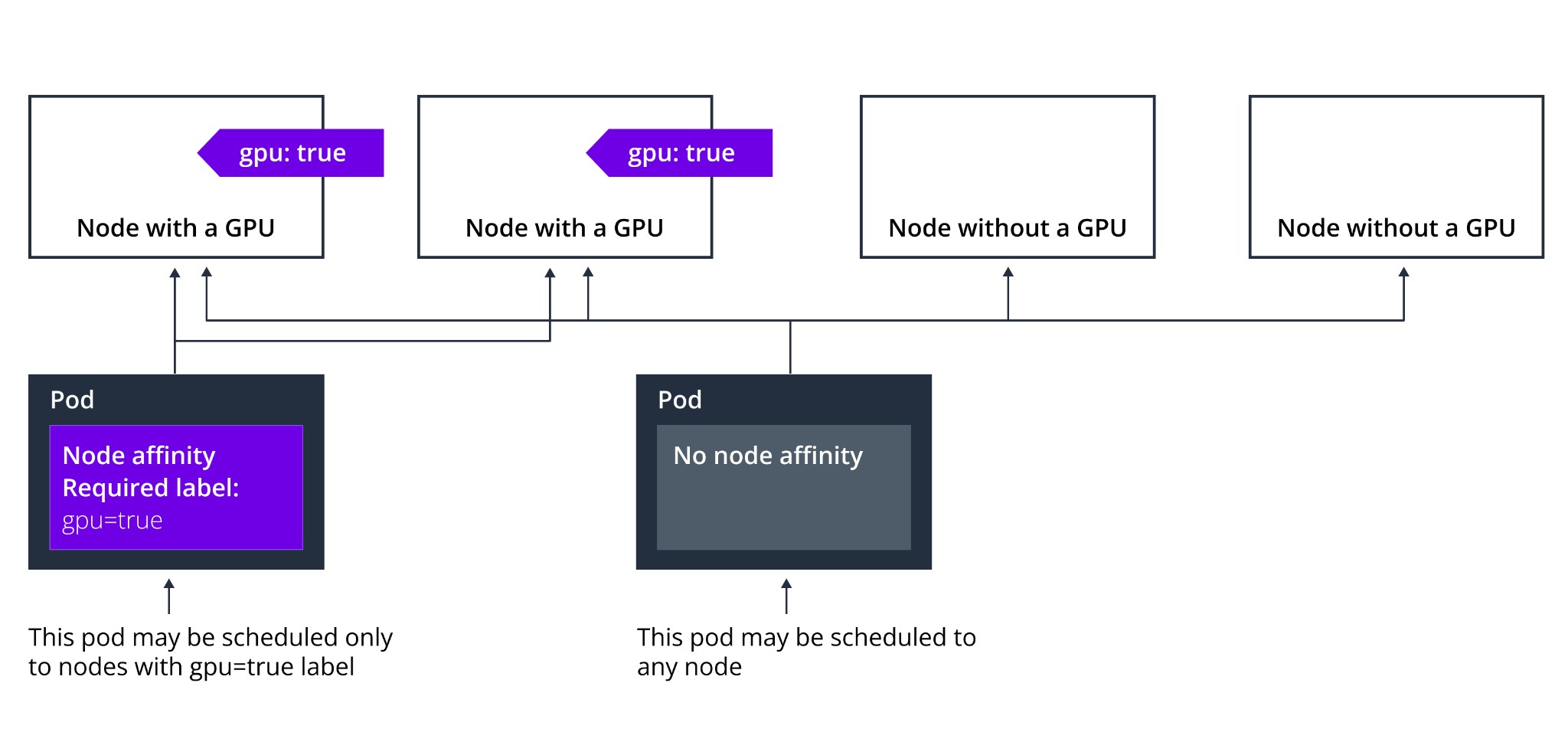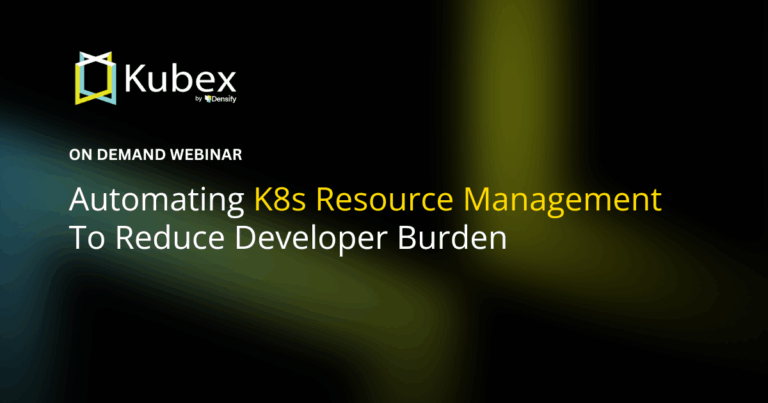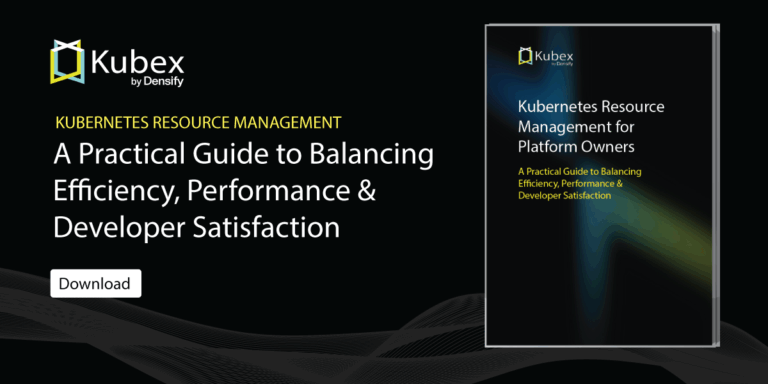Kubernetes Affinity
Chapter 9- Introduction: Kubernetes Autoscaling
- Chapter 1: Vertical Pod Autoscaler (VPA)
- Chapter 2: Kubernetes HPA
- Chapter 3: K8s Cluster Autoscaler
- Chapter 4: K8s ResourceQuota Object
- Chapter 5: Kubernetes Taints & Tolerations
- Chapter 6: Guide to K8s Workloads
- Chapter 7: Kubernetes Service Load Balancer
- Chapter 8: Kubernetes Namespace
- Chapter 9: Kubernetes Affinity
- Chapter 10: Kubernetes Node Capacity
- Chapter 11: Kubernetes Service Discovery
- Chapter 12: Kubernetes Labels
Kubernetes (K8s) scheduler often uses simple rules based on resource availability to place pods on nodes. That’s fine for many use cases. However, sometimes, you may need to go beyond simple resource-based scheduling.
For example, what if you want to schedule pods on specific nodes? Or, what if you want to avoid deploying specific pods on the same nodes?
That’s where Kubernetes affinity and Kubernetes anti-affinity come in. They are advanced K8s scheduling techniques that can help you create flexible scheduling policies.
In general, affinity enables the Kubernetes scheduler to place a pod either on a group of nodes or a pod relative to the placement of other pods. To control pod placements on a group of nodes, a user needs to use node affinity rules. In contrast, pod affinity or pod anti-affinity rules provide the ability to control pod placements relative to other pods.
In this article, to help you hit the ground running with Kubernetes affinity, we’ll take a closer look at advanced scheduling methods, deep-dive into the different types of K8s affinity, and provide a node affinity demo so you can get hands-on with Kubernetes advanced scheduling.
Kubernetes Advanced Pod Scheduling Techniques
Before we jump into Kubernetes affinity, let’s take a step back and review the different custom pod scheduling techniques available to us. In the table below, you’ll see a breakdown of the various advanced scheduling methods, including Node Affinity and Pod Affinity/Anti-Affinity.
| Technique | Summary |
|---|---|
| Taints and Tolerations | Allowing a Node to control which pods can be run on them and which pods will be repelled. |
| NodeSelector | Assigning a Pod to a specific Node using Labels |
| Node Affinity | Similar to NodeSelector but More expressive and flexible such as adding “Required” and “Preferred” Rules |
| Pod Affinity and Anti-Affinity | Co-locating Pods or Placing Pods away from each other based on Affinity and Anti-Affinity Rules |
Now let’s take a closer look at each technique.
K8s Taints and Tolerations
With Taints, nodes have control over pod placement. Taints allow nodes to define which pods can be placed on them and which pods are repelled away from them.
For example, suppose you have a node with special hardware and want the scheduler only to deploy pods requiring the special hardware. You can use Tolerations for the node’s Taints to meet this requirement.
The pods that require special hardware must define toleration for the Taints on those nodes. With the Toleration, the nodes will allow the pods to run on them.
K8s NodeSelector
NodeSlector is the simplest way to schedule a pod on a node. It works by defining a label for a node and then binding the pod to that node by matching the label in the pod spec. It is a simple approach that works in some cases. However, it is not flexible enough for complex pod scheduling.
Spend less time optimizing Kubernetes Resources. Rely on AI-powered Kubex - an automated Kubernetes optimization platform
Free 30-day TrialNode Affinity
Node affinity rules use labels on nodes and label selectors in the pod specification file. Nodes don’t have control over the placement. If the scheduler places a pod using the node affinity rule and the rule is no longer valid later (e.g., due to a change of labels), the pod will continue to run on that node.
There are many use cases for node affinity, including placing a pod on a group of nodes with a specific CPU/GPU and placing pods on nodes in a particular availability zone.

There are two types of Node Affinity rules:
- Required
- Preferred
Required rules must always be met for the scheduler to place the pod. With preferred rules the scheduler will try to enforce the rule, but doesn’t guarantee the enforcement.
Pod Affinity and Pod Anti-Affinity
Pod Affinity and Anti-Affinity enable the creation of rules that control where to place the pods relative to other pods. A user must label the nodes and use label selectors in pod specifications.
Pod Affinity/Anti-Affinity allows a pod to specify an affinity (or anti-affinity) towards a set of pods. As with Node Affinity, the node does not have control over the placement of the pod.
Affinity rules work based on labels. With an affinity rule, the scheduler can place the pod on the same node as other pods if the label on the new pod matches the label on the other pod.

An anti-affinity rule tells the scheduler not to place the new pod on the same node if the label on the new pod matches the label on another pod. Anti-affinity allows you to keep pods away from each other. Anti-affinity is useful in cases such as: avoiding placing a pod that will interfere in the performance of an existing pod on the same node.

Like Node Affinity rules, Pod affinity rules also have “Required” and “Preferred” modes. In the “Required” mode, a rule must be met for the scheduler to place the pod. In “Preferred” mode, scheduling based on the rule is not guaranteed.
Node Affinity Demo
Now that you understand Kubernetes affinity let’s jump into our Node Affinity demo.
In this demo, we’ll go through step-by-step instructions to:
- Explain how Node Affinity rules work by labeling some nodes in the cluster
- Create a deployment with a Node Affinity rule in a pod specification
- See that the pods are placed on the nodes with given labels.
First let us see the list of nodes in the cluster:
$ kubectl get nodes
NAME STATUS ROLES AGE VERSION
k8s-node-master-1 Ready controlplane,etcd 723d v1.15.12
k8s-node-master-2 Ready controlplane,etcd 723d v1.15.12
k8s-node-master-3 Ready controlplane,etcd 723d v1.15.12
k8s-node-worker-1 Ready worker 723d v1.15.12
k8s-node-worker-2 Ready worker 723d v1.15.12
k8s-node-worker-3 Ready worker 723d v1.15.12
k8s-node-worker-4 Ready worker 723d v1.15.12
Label two nodes for node affinity demo, so that the pods can be placed on labeled nodes by affinity rule:
Spend less time optimizing Kubernetes Resources. Rely on AI-powered Kubex - an automated Kubernetes optimization platform
Free 30-day Trial
$ kubectl label node k8s-node-worker-3 app=frontend
node/k8s-node-worker-3 labeled
$ kubectl label node k8s-node-worker-4 app=frontend
node/k8s-node-worker-4 labeled
Next, create a namespace for the demo:
$ kubectl create ns test
namespace/test created
Next, create the following deployment file with node affinity in the pod spec:
apiVersion: apps/v1
kind: Deployment
metadata:
name: node-affinity
namespace: test
spec:
replicas: 4
selector:
matchLabels:
run: nginx
template:
metadata:
labels:
run: nginx
spec:
containers:
- image: nginx
imagePullPolicy: Always
name: nginx
affinity:
Node affinity:
requiredDuringSchedulingIgnoredDuringExecution:
nodeSelectorTerms:
- matchExpressions:
- key: app
operator: In
values:
- frontend
Spend less time optimizing Kubernetes Resources. Rely on AI-powered Kubex - an automated Kubernetes optimization platform
Free 30-day TrialNow, create the deployment using the YAML file:
$ kubectl create -f deployment-node-affinity.yml
deployment.apps/node-affinity created
Next, see if the deployment was created successfully:
$ kubectl get deploy -n test
NAME READY UP-TO-DATE AVAILABLE AGE
node-affinity 4/4 4 4 10s
Next, get the list of pods created:
$ kubectl get pods -n test
NAME READY STATUS RESTARTS AGE
node-affinity-7fd7f8f75f-dng7b 1/1 Running 0 30s
node-affinity-7fd7f8f75f-frsxz 1/1 Running 0 30s
node-affinity-7fd7f8f75f-nn6jl 1/1 Running 0 30s
node-affinity-7fd7f8f75f-wpc66 1/1 Running 0 30s
Next, to check if the pod affinity rule worked, get the list of pods on nodes and make sure the pods were placed on nodes with label app=frontend, i.e worker3, worker4 in this case:
$ kubectl get pod -o=custom-columns=NODE:.spec.nodeName,NAME:.metadata.name -n test
NODE NAME
k8s-node-worker-4 node-affinity-7fd7f8f75f-dng7b
k8s-node-worker-4 node-affinity-7fd7f8f75f-frsxz
k8s-node-worker-3 node-affinity-7fd7f8f75f-nn6jl
k8s-node-worker-3 node-affinity-7fd7f8f75f-wpc66
Finally, clean up the demo resources:
$ kubectl delete ns test --cascade
namespace "test" deleted
Pod Affinity and Anti-Affinity Demo
Let’s assume we have a Redis cache for web applications and we need to run three replicas of Redis but we need to make sure that each replica runs on a different node, we make use of pod anti-affinity here.
Redis deployment with pod anti-affinity rule, so that each replica lands on a different node:
cat redis.yaml
apiVersion: apps/v1
kind: Deployment
metadata:
name: redis-cache
namespace: test
spec:
selector:
matchLabels:
app: store
replicas: 3
template:
metadata:
labels:
app: store
spec:
affinity:
podAntiAffinity:
requiredDuringSchedulingIgnoredDuringExecution:
- labelSelector:
matchExpressions:
- key: app
operator: In
values:
- store
topologyKey: "kubernetes.io/hostname"
containers:
- name: redis-server
image: redis:3.2-alpine
Create the deployment using the yaml file above:
kubectl create -f redis.yaml
deployment.apps/redis-cache created
Spend less time optimizing Kubernetes Resources. Rely on AI-powered Kubex - an automated Kubernetes optimization platform
Free 30-day TrialGet the deployment is up
$ kubectl -n test get deploy
NAME READY UP-TO-DATE AVAILABLE AGE
redis-cache 3/3 3 3 11s
Check if each pod is running on different node:
$ kubectl get pod -o=custom-columns=NODE:.spec.nodeName,NAME:.metadata.name -n test
NODE NAME
k8s-node-worker-3 redis-cache-67786cc786-bgxtp
k8s-node-worker-1 redis-cache-67786cc786-btppc
k8s-node-worker-2 redis-cache-67786cc786-dchf7
We noticed that each pod is running on a different node.
Next, let’s assume we have a web server running and we need to make sure that each web server pod co-locates with each Redis cache pod, but at the same time, we need to make sure two web server pods don’t run on the same node, for this to happen we make use of pod affinity and pod anti-affinity both as below.
Create the deployment file with affinity and anti-affinity rules:
cat web-server.yaml
apiVersion: apps/v1
kind: Deployment
metadata:
name: web-server
namespace: test
spec:
selector:
matchLabels:
app: web-store
replicas: 3
template:
metadata:
labels:
app: web-store
spec:
affinity:
podAntiAffinity:
requiredDuringSchedulingIgnoredDuringExecution:
- labelSelector:
matchExpressions:
- key: app
operator: In
values:
- web-store
topologyKey: "kubernetes.io/hostname"
podAffinity:
requiredDuringSchedulingIgnoredDuringExecution:
- labelSelector:
matchExpressions:
- key: app
operator: In
values:
- store
topologyKey: "kubernetes.io/hostname"
containers:
- name: web-app
image: nginx:1.12-alpine
Create the deployment:
kubectl create -f web-server.yaml
deployment.apps/web-server created
List the pods along with nodes and check that they are placed as required by rules:
kubectl get pod -o=custom-columns=NODE:.spec.nodeName,NAME:.metadata.name -n test
NODE NAME
k8s-node-worker-3 redis-cache-67786cc786-bgxtp
k8s-node-worker-1 redis-cache-67786cc786-btppc
k8s-node-worker-2 redis-cache-67786cc786-dchf7
k8s-node-worker-1 web-server-84b9456f9b-dhd9x
k8s-node-worker-3 web-server-84b9456f9b-lf6xs
k8s-node-worker-2 web-server-84b9456f9b-zbjq2
We noticed that each web pod is co-located with a redis pod, and no two web pods are running on the same node; this was done by using pod affinity and anti-affinity rules.
Conclusion
Affinity and anti-affinity provide flexible ways to schedule pods on nodes or place pods relative to other pods. You can use affinity rules to optimize the pod placement on worker nodes for performance, fault tolerance, or other complex scheduling requirements.
FAQs
What is Kubernetes Affinity?
Kubernetes Affinity is an advanced scheduling feature that controls how pods are placed on nodes. It lets administrators define rules for co-locating pods (affinity) or keeping them apart (anti-affinity).
What are the types of Kubernetes Affinity?
There are two main types of Kubernetes Affinity. Node Affinity controls which nodes pods can be scheduled on, based on node labels. Pod Affinity and Pod Anti-Affinity manage pod placement relative to other pods, ensuring they either run together (co-location) or stay separated.
How is Kubernetes Affinity different from NodeSelector?
NodeSelector only supports simple key-value matches, while Kubernetes Affinity allows more expressive rules, including required vs. preferred constraints and complex label-based expressions.
When should I use Pod Anti-Affinity?
Use Pod Anti-Affinity when you want to spread pods across nodes for high availability, such as ensuring multiple replicas of a database or cache don’t run on the same node.
What are best practices for Kubernetes Affinity rules?
Best practices include combining affinity with taints and tolerations for precise scheduling, using labels consistently, preferring “preferred” rules for flexibility, and testing configurations in staging before production.
Try us
Experience automated K8s, GPU & AI workload resource optimization in action.



